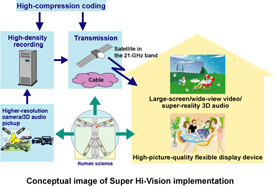 HDTV – Already On the Road to Obsolescence?
HDTV – Already On the Road to Obsolescence?
By Jim Bray
High definition television is hot and getting hotter.
But is today’s HDTV merely a way station on the road to really, really
high definition television broadcasts?
Of course! There’s always a new technology just over the horizon (consider
it job security for engineers, retailers and writers!), and if the Japan Broadcasting
Corporation NHK has its way, we could all be watching its latest HD tour de
force, "Super Hi-Vision" sometime down the road.
NHK’s new high definition television technology ups the pixel ante substantially:
the company says it’s 16 times better than the 1920x1080 TV’s occupying
sales floors as you read this.
Hype, or hope for the future? At this stage of the game no one knows for sure,
but it may not be wise to scoff at NHK. This is a company that has been pushing
the HDTV technology envelope for many years. In fact, their analog system was
around long before most people in North America had even heard the term High
Definition Television.
Unfortunately for NHK, their HD system became technological road kill in North
America when the U.S. FCC mandated a digital route to HD heaven.
Despite that corporate speed bump, however, it appears NHK hasn’t been
sitting back licking its wounds, but instead has been working hard in the lab
to raise the technology to newer and greater heights.
Hence Super Hi-Vision, which the broadcaster rolled out at the World Exposition
in Aichi, Japan late last year. NHK demonstrated Super Hi-Vision using a 600
inch screen to wow the audiences.
How good was it? Well, I wasn't there, but NHK says Super Hi-Vision is so
lifelike that "viewers could feel as though they were actually at the
broadcasting site, or that the object they are viewing is right in front of
them."
Works for me. Having had my socks knocked off by "The Polar Express" in
3D IMAX last Christmas, I can assure you that, as good as it is, today’s
HD isn’t the be-all and end-all. So maybe NHK really is inventing the
next "better mousetrap" and hoping that, this time, the world will
beat that proverbial path to its door.
It isn’t merely a new video standard, either. NHK is positioning Super
Hi-Vision as a whole new ball game for high quality programming delivery, for
both video and audio reproduction. Here’s what they claim the technology
will deliver:
- A resolution of 7,680×4,320 pixels (for a total of 33,177,600 pixels
compared with 1080’s 2,073,600!) progressively scanned at a 60-Hz frame
rate.
- 16x9 aspect ratio
- A 22.2 channel 3D loudspeaker setup (which should make audio manufacturers
and retailers happy!)
- 21-GHz band broadcasting satellites to deliver the Super Hi-Vision signal
to homes. NHK says they’re studying "special compensation technologies
employing a phased array antenna system to solve radio attenuation problem
caused by rain in 21-GHz band."
I have no idea what that technical stuff means, but if nothing else it appears
to indicate that these people are trying to cover all the bases, even to minimizing
the effects of weather on transmission.
To create the content, NHK developed a camera equipped with 8 megapixel CCD
image sensors capable of taking 4K x 8K pixel images. For the demonstration,
they set up two cameras in a sea park and transmitted live, uncompressed baseband
signals back to the theater (which was about 20 miles away) via a fiberoptic
network.
NHK senior research engineer, Mikio Maeda, was quoted as saying the huge amount
of information the technology requires made it difficult to transmit the test
signals. I can imagine!
The demonstration was successful, however, leading NHK to proclaim that Super
Hi-Vision is viable as a future broadcasting technology.
Besides the source and transmission sides of the equation, NHK says it’s
working on building a lightweight, low profile home display device, which will
be necessary if they want consumers to actually watch the Super Hi-Vision programming.
The company’s website has a couple of conceptual drawings (very small
ones, alas), one of which depicts a huge screen that would look really great
in my home theater, as well as a small, computer monitor-type panel.
Naturally, the system will require everyone to buy new equipment, from content
creators through broadcasters and all the way to the end user. This is probably
the last thing anyone wants to do for the foreseeable future, however, since
everyone involved is still investing heavily in today’s HD equipment
and the idea of getting back on the "replace and upgrade merry go round" won’t
have much appeal until the current stuff has had a few years to pay for itself.
NHK isn’t talking about Super Hi-Vision becoming available any time
soon, however. According PC World, NHK says the technology is "unlikely
to be commercialized until sometime in the next decade."
Even if Super Hi-Vision does make it to the marketplace, the first generations
will undoubtedly be very expensive, so it’ll be several years after that
for it to become a mainstream consumer item.
And if history is any indicator, it may never reach us anyway.
So there’s still plenty of time to enjoy one of those HDTV’s in
stores today.
Copyright 2006 Jim Bray
TechnoFile.com